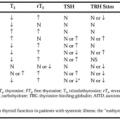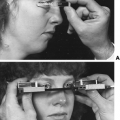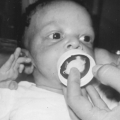SILENT THYROIDITIS ETIOLOGY
Part of “CHAPTER 46 – THYROIDITIS“
During the past two decades, physicians increasingly have observed patients presenting with signs and symptoms of thyrotoxicosis; a small, painless, nontender goiter; and a low RAI uptake. Furthermore, the thyrotoxicosis has been transient. This syndrome, usually termed silent thyroiditis (absence of thyroid pain)40 also has been termed hyperthyroiditis,41 painless subacute thyroiditis, atypical subacute thyroiditis, and lymphocytic thyroiditis with spontaneously resolving hyperthyroidism. It is apparent from the range of the terms used to describe this disorder that the etiology and relation to several other forms of thyroiditis are somewhat unclear. Additionally, the reported frequency with which silent thyroiditis causes thyrotoxicosis ranges widely, from 4% to 23%.42, 43 The clinical course resembles that seen in subacute thyroiditis in regard to thyroid function. At biopsy, however, the thyroid tissue from patients with silent thyroiditis reveals findings more suggestive of Hashimoto disease (chronic lymphocytic thyroiditis), because extensive lymphocytic infiltration is observed. Often, severe disruption of the follicles is seen, Hürthle cell transformation is absent, and occasionally lymphoid follicles are present.44 Despite these histologic changes that are compatible with Hashimoto thyroiditis, as many as 40% of patients with silent thyroiditis do not have significantly elevated titers of antimicrosomal or antithyroglobulin antibodies, the serologic hallmark of Hashimoto disease.7
Silent thyroiditis is associated with an excess of HLA-DR3.45 This association links silent thyroiditis to autoimmune thyroiditis rather than to subacute thyroiditis.46 Other observations that implicate an autoimmune etiology for this entity are the onset of silent thyroiditis (which has been observed after the resection of a thymoma)47 and the appearance of a mixture of TSH-receptor antibodies that may mediate the various phases of thyroid function that are observed.48 Silent thyroiditis has also been reported in conjunction with amiodarone7 and lithium, and with the use of interferon-α in the treatment of hepatitis C patients.49, 50 The prevalence of antibodies before interferon treatment generally is low,51 but treatment may induce antibodies in as many as 15% of patients, most of whom may experience thyrotoxicosis and/or hypothyroidism.52 A report53 was made of silent thyroiditis in a husband whose wife previously had subacute thyroiditis. Similar to subacute thyroiditis, the thyrotoxicosis54 in silent thyroiditis results from damage to follicular cells by the inflammatory process, with the subsequent release of excessive amounts of thyroid hormone. This process also impairs the capacity of the thyroid to trap iodine—hence, the observed low RAI uptake. Because the damaged follicular cells temporarily cannot make additional thyroid hormone, patients experience a euthyroid phase and then become hypothyroid when the stored thyroid hormone is depleted; in most cases, they ultimately are restored to euthyroidism. The presence of high titers of anti-TPO (especially in the postpartum variety) may predispose to permanent hypothyroidism.
Stay updated, free articles. Join our Telegram channel

Full access? Get Clinical Tree






